Lal R., Shukla M.K. Principles of Soil Physics
Подождите немного. Документ загружается.

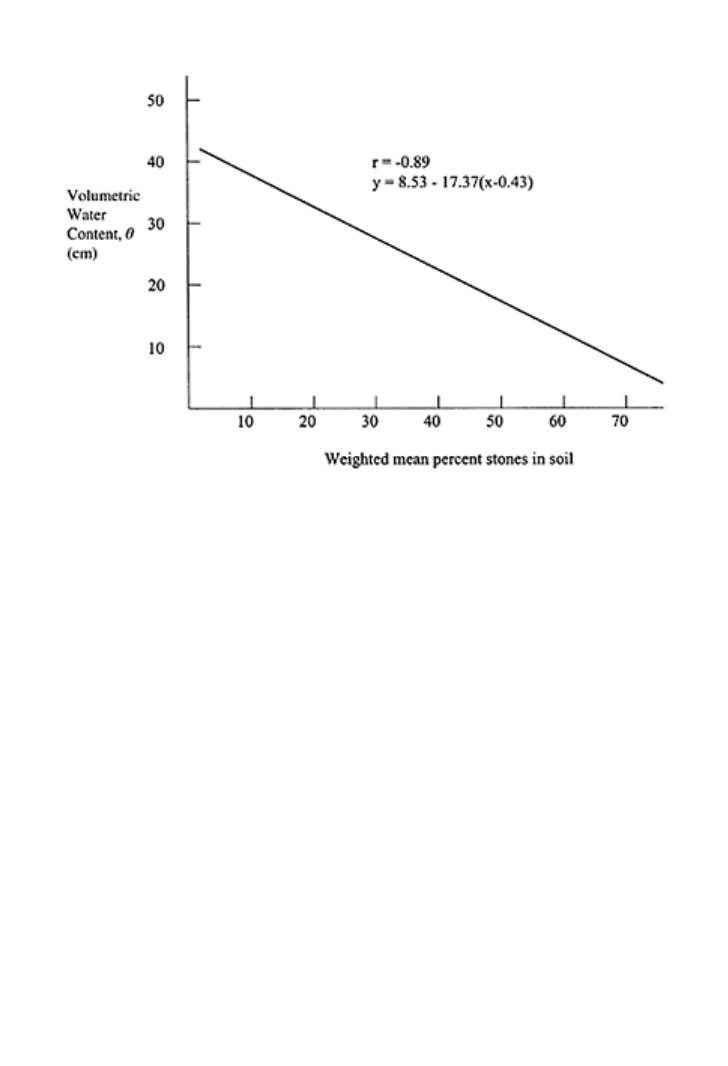
equation implies that as gravel content of soil increases the available water capacity
decreases (Fig. 19.3).
FIGURE 19.3 The influence of stones
on water content of a 120 cm deep soil
profile. Data presented here is from 40
soil profiles representing four soil
series in Oregon. (Modified from
Dryness, 1969, and Fisher and
Binkley, 2000.)
19.3 EFFECT OF SOIL TEXTURE ON NEUTRON PROBE
CALIBRATION
Soil water content determined by the neutron thermolization technique is also affected by
the presence of gravels and other coarse fragments in the soil. Soil texture significantly
altars the thermal neutron count (Gormat and Goldberg, 1972). The presence of gravels in
the soil decreases the density of thermal neutrons by scatter or reflection (McHenry,
1963). The calibration curve relating neutron count ratio to moisture content can have
similar slopes for sand and clayey soils. The intercept for a clayey soil is mostly positive
compared to a sandy soil having a zero intercept (Fig. 19.4); however, for gravelly soils,
the slope of the neutron probe calibration curve is greater than that for fine-textured soils
(Fig. 19.4) (Lal, 1974). Therefore, developing a site-specific calibration of the neutron
moisture probe is essential for gravelly soils. Similarly, use of time domain
reflectometery (TDR) for field moisture content, gypsum block for electrical resistance
Principles of soil physics 564
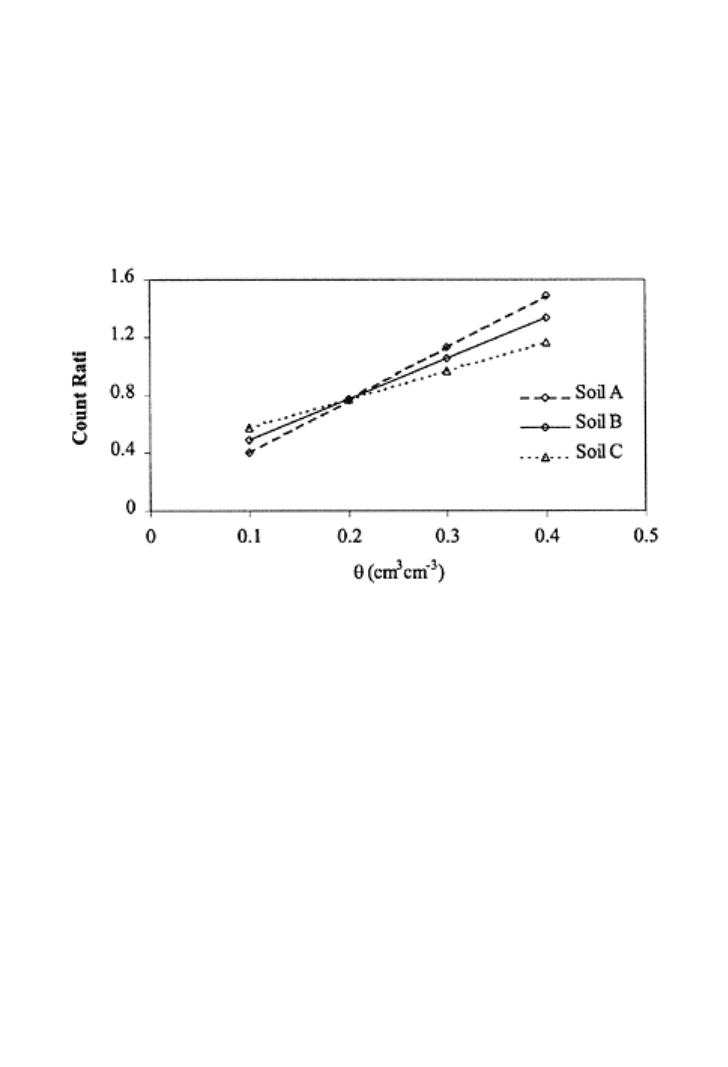
(which can be converted to suction and moisture content by developing empirical
relationships), and tensiometer (for soil suction) may also be problematic because of the
poor contact between the probe and soil. The site-specific calibrations are also suggested
for these devices.
19.4 HYDRAULIC CONDUCTIVITY
Saturated hydraulic conductivity (K
s
) is an important input to the water infiltration
models (see Chapter 14). In gravelly soils, the gravels impede
FIGURE 19.4 Effect of soil texture on
neutron probe calibration for moisture
content determinations for soil A
(0.8% gravel, 41% sand, and 15.2%
clay content), soil B (59.7%, 27.1%,
7.3%), and soil C (8.2%, 16.3%,
63.9%). (Recalculated and drawn from
Lal, 1974.)
both excavation of the hole with controlled geometry and collection of a representative
sample. When K
s
values are expressed as a function of matric potential, the gravel
content does not influence their values. However, expressing K
s
as a function of
volumetric moisture content, the apparent conductivities for given moisture content are
higher when gravels are present. The unsaturated conductivity [K(θ)] for a gravelly soil
can be estimated from measurements made on fine-earth fraction by applying a
correction, which reduces the moisture content and area available for flow. The gravels
present in the soil can decrease the overall K(θ) (Mehuys et al., 1975). The soil hydraulic
conductivity for a gravelly soil can be calculated as follows (Peck and Watson, 1979):
Physical properties of gravelly soils 565
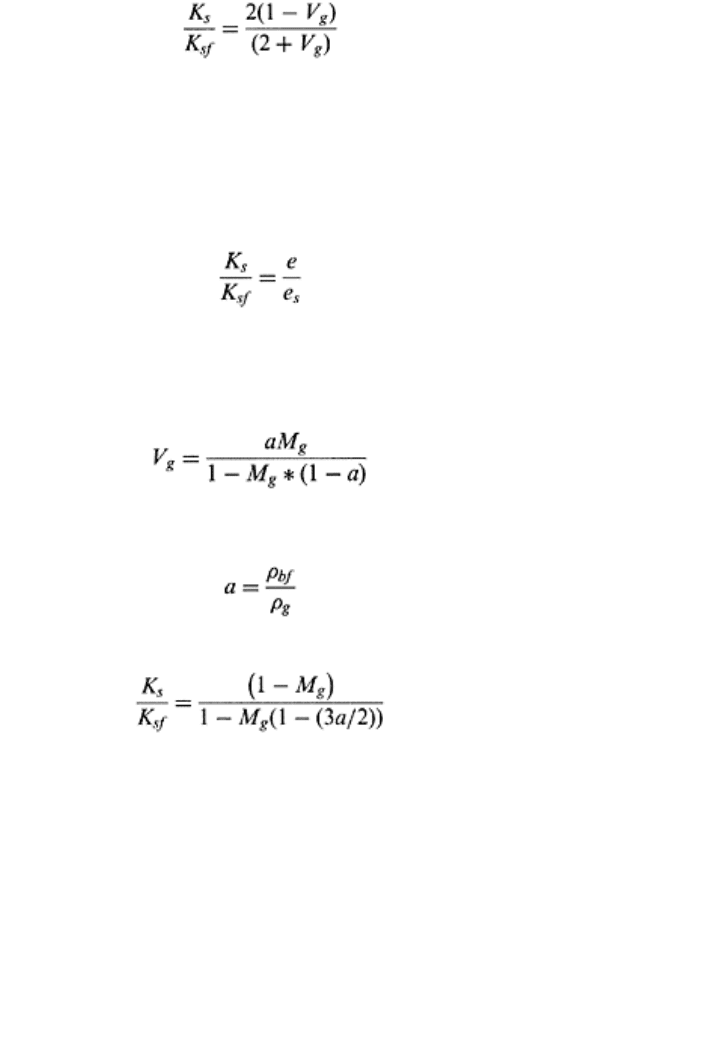
(19.13)
where K
s
is the saturated hydraulic conductivity of bulk soil (gravel+soil), K
s
f is the
saturated hydraulic conductivity of fine-earth, and V
g
is the volume fraction of gravels.
Equation (19.13) assumes that gravels have zero conductivity, which is a major drawback
of this equation. At higher gravel contents, the equation can over predict or under predict
the conductivity depending upon the porosity and moisture status of gravels. This
drawback can be overcome by relating the soil conductivity to the void ratios for both
bulk soil gravel system and pure sand as follows (Bouwer and Rice, 1984):
(19.14)
where e is the bulk void ratio of a sand gravel mixture, which is the volume of voids
divided by volume of solids, and e
s
is the void ratio of sand. Equation (19.13) can be
modified by taking into account the ratios of bulk density of fine-earth fraction and gravel
fraction as follows (Brakensiek and Rawls, 1994):
(19.15)
where M
g
is the gravimetric gravel fraction, and a is the ratio of bulk density of fine-earth
material and gravel fraction as follows:
(19.16)
Substituting Eq. (19.15) into (19.13) yields
(19.17)
19.5 WATER INFILTRATION
The influence of a pure gravel layer on water infiltration can be different based upon
whether the gravel layer is located below a layer of fine earth material or above it. The
water flow through the gravel soil interfaces depends upon the suction gradients across
the interface. Let us consider two situations: (i) a gravel layer underlying a fine earth
material, and (ii) gravel layer overlaying a fine-earth material. Let us apply water on both
soil profiles for a long period. If a gravel layer exists below a layer of fine earth material
(Fig. 19.5a), the infiltrating water will not move downward into the gravel layer unless
the top fine earth layer is saturated. Thus, the flow is impeded or retarded. This is because
the gravelly layer is at atmospheric
Principles of soil physics 566

FIGURE 19.5 The schematic of gravel
and fine earth material: (a) gravel layer
underlying a fine earth material
(impedes infiltration) and (b) gravel
overlying a fine earth material
(increases infiltration.)
pressure and therefore, at higher pressure than the overlaying fine soil. Once the
overlaying soil layer gets saturated, the positive pressure (positive pressure gradient
between fine earth and gravels) forces the water entry into the gravelly horizon. On the
other hand, if gravels are overlaying a layer of fine earth material (Fig 19.5b), the high
porosity associated with gravels will let water infiltrate in the profile rather quickly.
Regardless, the rate of water infiltration into the layered profile is less than that into a
homogeneous soil.
Quantifying factors affecting infiltration of water into soil is crucial for modeling soil
erosion and water balance. Infiltration characteristics are significantly influenced by soil
properties, soil sealing, and gravel content (Valentin, 1994). During rainfall, gravels at
the soil surface intercept rain, which can be: (i) stored at surface, (ii) absorbed by the
gravels, (iii) carried as overland flow, or (iv) evaporated on surface.
The gravel cover at the soil surface has an ambivalent effect on infiltration,
percolation, and overland flow (Poesen and Lavee, 1994). The gravels in the top layer
exert a significant control on infiltration and in some cases can produce flow, which
increases the overland flow (Casenave and Valentin, 1992; Poesen et al., 1990). On the
other hand, gravels protect the soil surface from rainfall impact and reduce surface
crusting and soil sealing, which increases infiltration rate of soil (Valentin, 1994). In
general, gravels increase or decrease the total amount of infiltration depending on their
Physical properties of gravelly soils 567
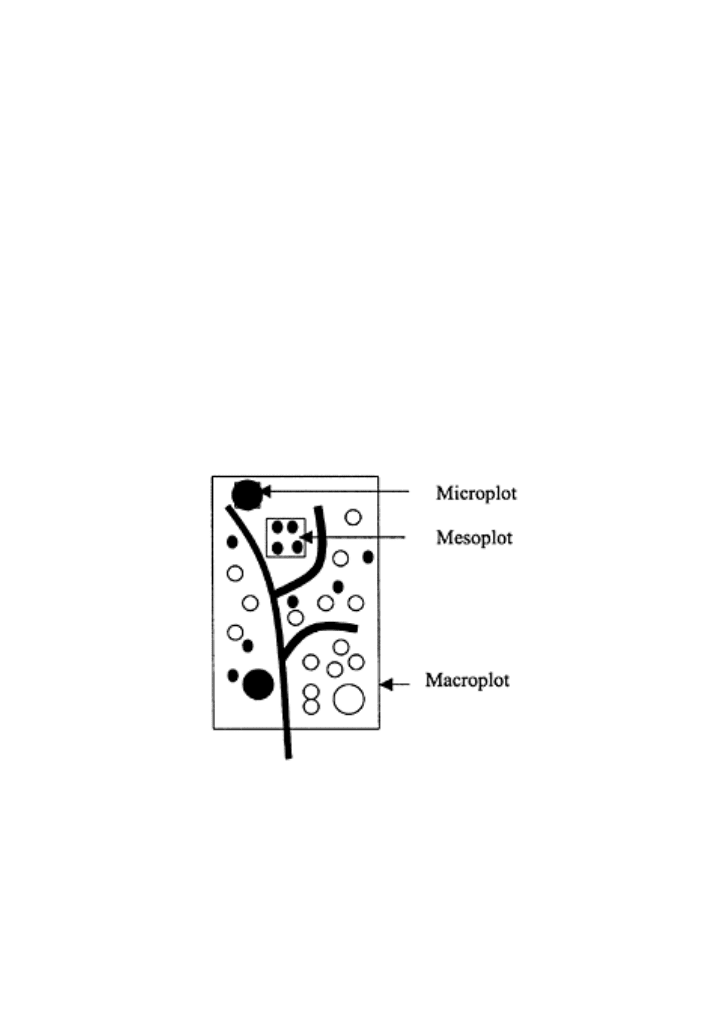
size, position, cover, and the structure of the fine earth around them (Poesen et al., 1990;
Valentine, 1994). The size and position of gravels are important factors at the microscale,
which controls overland flow near the edge. The cover percentage of gravels is important
at macroscale, which controls the continuity of overland flow along a hill slope.
19.6 SOIL EROSION
Gravels at the soil surface or in the top layer can significantly influence soil erosion by
water and wind. Depending upon the temporal and spatial scales, gravels can have a
favorable or adverse effect on water erosion. Some of the favorable effects can be
grouped into two classes: direct and indirect influences. The direct effects include: (i)
reduction in soil detachment by raindrop splash, (ii) interception of splashed sediment,
and (iii) reduction in sediment loaded runoff. The indirect influences are: (i) reduction in
surface sealing and compaction, (ii) increase in aggregation, infiltration, and percolation,
and (iii) reduction in loss of nutrient and dissolved organic carbon (DOC). Similar effects
apply to wind erosion,
On a temporal scale, the soil erosion by water can expose large sized gravels, which
act as an erosion pavement and reduce soil erosion in the long
FIGURE 19.6 The schematic of
micro-, meso-, and macroplots for
studying soil erosion by water.
(Modified from Poesen et al., 1994.)
run. On a spatial scale (micro-, meso-, and macroplots) (Fig. 19.6), single large gravel,
which corresponds to a microplot, protects the soil under it from erosion by rainfall or
runoff. The mass of sediment detached by raindrop impact on a bare interrill soil surface
partly covered by gravels per unit area per unit time (SD) can be estimated by:
SD=(1−C
g
)(KE)R
−1
(19.18)
Principles of soil physics 568
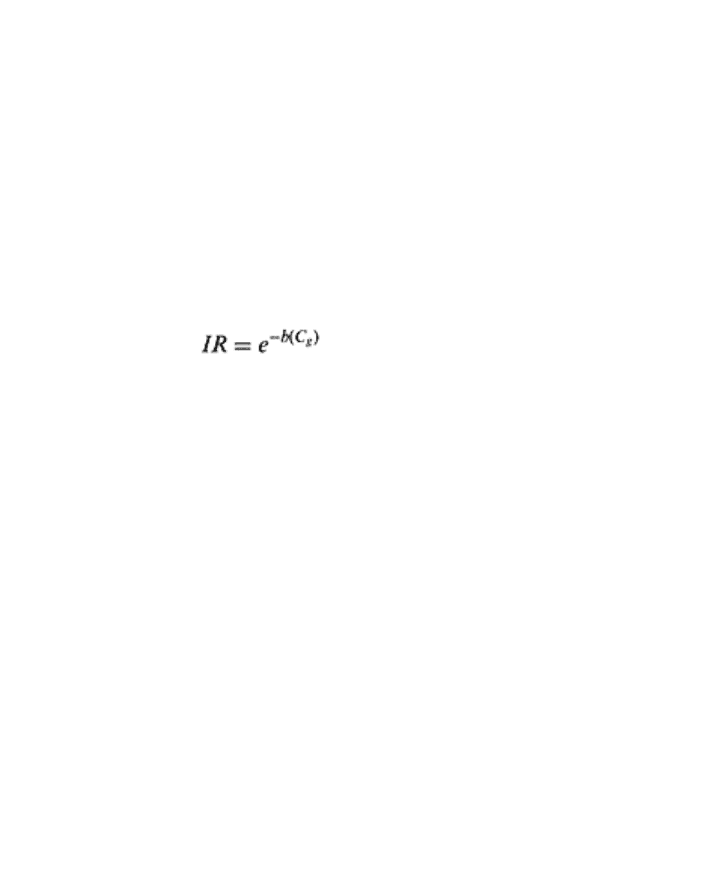
where C
g
is gravel cover (fraction), KE is the kinetic energy of rainfall per unit area and
per unit time (Jm
−2
h
−1
), and R is the resistance of bare soil detachment (J kg
−1
) (Poesen et
al., 1994).
Moving on to a mesoplot scale, the interrill area around the large gravels is also
included. On a macroplot scale a combination of interrill, rill, and in some cases gullied
areas are all included. Therefore, in a natural diversity of an entire slope, a combination
of several erosion processes take place simultaneously (Poesen et al., 1994). In a
mesoscale, i.e., on interrills, effects of gravel on soil erosion can be ambivalent and
largely depend on their size, land slope, and type of soil. On macroscale, the soil erosion
is the result of combined subprocesses taking place at the micro and mesoscales. An
overall less sediment yield on a macroplot can overshadow the higher sediment yield
from a mesoplot. It has been generally observed that mean decrease in relative interrill
and rill sediments yield with gravel cover can be expressed by an exponential decay
function as follows (Poesen and Ingelmo-Sanchez, 1992):
(19.19)
where IR is relative interrill sediment yield and b is a coefficient indicating the
effectiveness of gravel cover. For cultivated topsoils, b values range from 0.02 to 0.06
(Poesen and Ingelmo-Sanchez, 1992).
19.7 TEMPERATURE AND EVAPORATION
A surface layer of gravel has a profound influence on temperature regimes of surface
horizon. In arid regions especially, the diurnal and seasonal temperature fluctuation are
large, and the maximum temperature is obtained in the afternoon. The temperature
fluctuations decrease very rapidly with depth, and at 50 cm and deeper, soil temperatures
are nearly constant although considerable lower in winter than summer. The thermal
properties of gravels are different than soil, therefore, gravels in soil alter the temperature
profile in the soil-gravel system.
The amplitude of temperature below large gravel is smaller than bare soil at a given
depth (Fig. 19.7). This is mainly because: (i) it acts as an insulator during hot hours of the
day and help retains soil heat during night, and (ii) heat flows from under it toward
surrounding soil (Jury and Bellantuoni, 1976). Soil water conditions are generally better
under gravels, and soil temperature fluctuations in a gravelly soil are also dependent on
soil water content. The temperature fluctuations in a moist gravelly soil are
Physical properties of gravelly soils 569
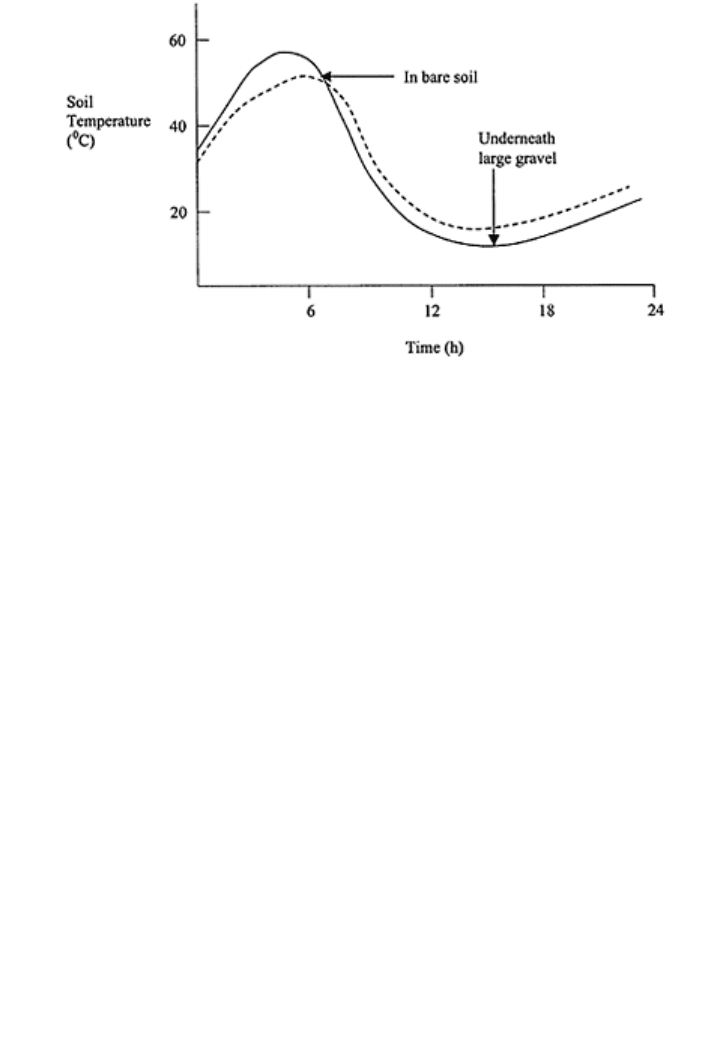
FIGURE 19.7 Schematic of a soil
temperature profile at a given depth
below and close to large gravel in the
bare soil.
lower than those in a dry one (Mehuys et al., 1975). The decrease in the amplitude for
moist soil at or near the soil surface occurs as evaporating water cools the soil surface. In
a dry soil surface with large gravel content, the daytime temperatures directly beneath the
soil are lower than away from it. However, for a similar situation in a moist soil, the
temperature beneath a surface gravel are higher than in the surrounding soil because of
the loss of latent heat to atmosphere from a gravel-free soil and increased conduction of
heat downward in moist areas.
The temperature is also dependent on the dimensions and color of the gravels. A
lighter colored gravel is cooler on its undersurface than a gray one (Larmuth, 1978). A
layer of gravels (embedded or lying on surface) at the soil surface can also act as mulch.
This gravel layer changes the radiation balance and temperature. Porous gravels have
generally low unsaturated hydraulic conductivity [K(θ)] at small suctions, which lets only
a small volume of water to be transported to the soil surface via capillary rise. Therefore,
evaporation losses are low (Unger 1971).
19.8 THERMAL PROPERTIES OF GRAVELLY SOILS
Heat transfer in a soil is characterized by the thermal diffusivity (D
T
, cm
2
s
−1
), which is
the ratio of thermal conductivity (k
T
, Jm
−1
s
−1
K
−1
) to heat capacity (C
v
, Jm
−3
K
−1
or C
g
,
Jkg
−1
K
−1
) (refer to Chapter 17 on temperature and heat flow). Thermal conductivity is the
rate of heat transfer along a unit temperature gradient and heat capacity is the amount
required to raise the temperature of soil by one degree. As the gravel con-tent increases
Principles of soil physics 570

so does the thermal conductivity (Table 19.8). For a dry soil the heat capacity also
increases linearly with increasing gravel content
TABLE 19.8 The Volumetric Rock Fragment
Content and Relative Thermal Conductivity (K
t
),
Relative Heat Storage Capacity (HC), and Thermal
Diffusivity (Df) in a Dry Soil
V
v
K
t
H
C
D
T
0 1 1 1
0.2 1.5 1.2 1.2
0.4 2.7 1.5 1.7
0.5 3.6 1.6 1.9
0.8 7.0 1.8 3.1
1.0 9.2 2.1 4.8
Source: Modified from Poeson and Lavee, 1994.
(Table 19.8). This is the reason why dry gravelly soils get warmer more rapidly than
gravel-free soils. Since the thermal diffusivity of dry gravelly soils is high, the total heat
flux into the soil is also high. The heat also penetrates deeper in a gravelly soil than a
gravel-free soil (Childs and Flint, 1990). Gravels can also induce lateral movement of
heat, which can cause water movement as well. Therefore, both heat and water vapor
move, mainly because of the horizontal temperature gradients induced by gravels, from
the adjacent soil towards the underside of the cooler fragments and causes moisture
condensation (Jury and Bellantuoni, 1976a, b).
19.9 ROOT GROWTH
Gravels influence soil’s edaphic environments. Gravelly soils may have adverse effects
on root growth if presence of gravels lead to a closed packing arrangment. In that
situation, smaller-sized gravels can have a more pronounced adverse effect on crop root
development than large sized gravels (Babalola and Lal, 1977b). The gravels at shallow
depths have inhibitory effects on root development. Total root length and root penetration
decrease with increasing gravel content (Table 19.9). The literature suggests as much as a
40% to 75% decline in root growth in gravelly soils, and as much as 70% in coarse sandy
soils (Takijima and Sauma, 1967; Babalola and Lal, 1911a). The penetration depth of
root declines rapidly with increase in gravel content. As depth to gravel layer increases
the depth of penetration of roots also increases. The shoot growth is also significantly
affected by the depth to gravel layer. In the leaf area, fresh and dry shoot weights increase
with increasing depth to gravel layer (Babalola and Lal, 1977a). For open packing, as is
the case in clayey soils,
Physical properties of gravelly soils 571
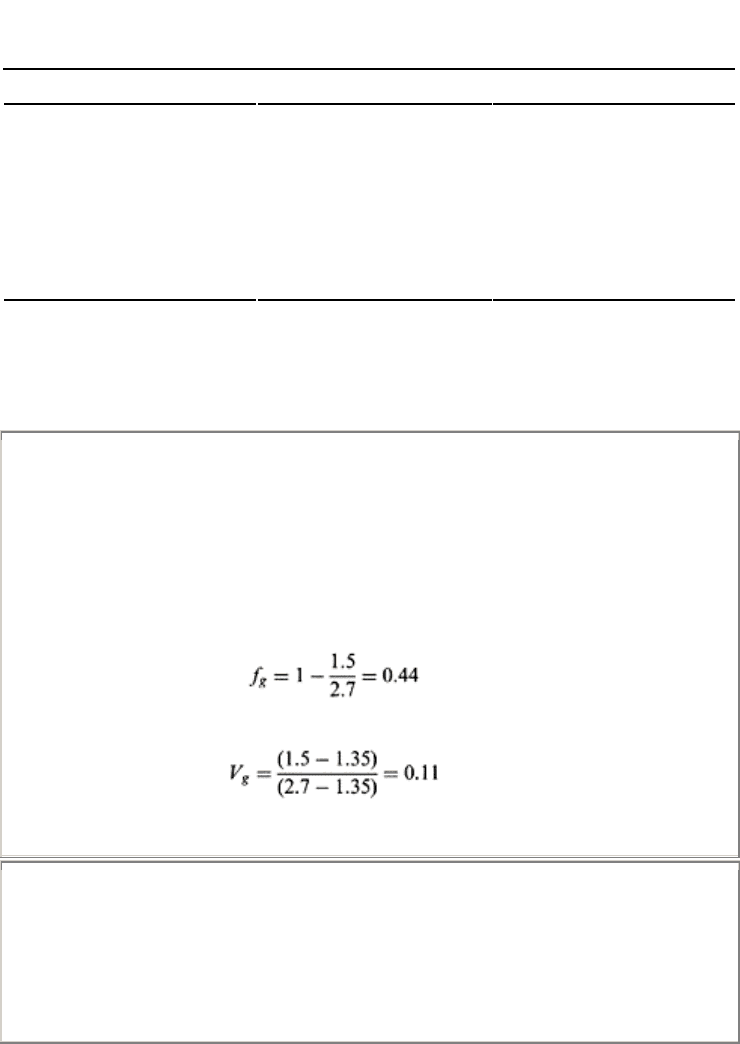
TABLE 19.9 Effect of Gravel Concentration on
Relative Depth and Length of Root Penetration
Gravel concentration (%) Relative root depth (%) Relative root length (%)
0 100 100
10 75 70
20 30 38
30 22 20
50 10 18
70 5 10
Source: Modified from Babalola and Lal, 1977a.
effect on root growth may be positive. In this case, gravels increase the porosity. Water
retention and availability for clayey soils, therefore, cause no adverse effects on root
development or productivity (Unger, 1971).
Example 19.1
If the gravimetric gravel content of a soil is 25 g, the total soil bulk density is 1.5 Mgm
−3
,
bulk density of fine earth is 1.35 Mgm
−3
, particle density of soil gravel is 2.7Mgm
−3
, and
the bulk density of gravel is 1.2Mgm
−3
, calculate the porosity of gravelly soil.
Solution
The porosity of gravel can be calculated from Eq. (19.1) as follows:
The volumetric gravel fraction (V
g
) of soil can be calculated by Eq. (19.2):
If the total volume of soil is 1 m
3
, the volumetric gravel content=0.11 m
3
.
Example 19.2
If the gravimetric mass of a soil-gravel fraction is 520 g and volume 442 cm3, calculate
the bulk density of the soil-gravel system. If the gravimetric mass of gravels is 25 g and
the volume displaced when immersed in pure water is 25 mL, calculate the bulk density
of gravel and gravel-free soil.
Principles of soil physics 572

Solution
The bulk density of a soil-gravel system can be directly calculated from weight and
volume of the soil-gravel system=520/442 =1.18 Mgm−
3
.
The bulk density of gravels=25/25=1 Mgm−
3
.
The bulk density of fine earth material (gravel-free soil)=(520–25)/ (442–25)=1.19
Mgm
−3
.
PROBLEMS
1. If the gravimetric mass of a gravel soil fraction is 550 g and volume 442 cm3,
calculate the bulk density of the soil-gravel system. If the gravimetric mass of gravel is
35 g and the volume displaced when immersed in pure water is 30 mL, calculate the bulk
density of gravels and gravel-free soil.
2. Calculate the porosity of gravel from data in Problem 1.
3. If the saturated hydraulic conductivity of a gravelly soil is 2 cmh−
1
, calculate the
saturated hydraulic conductivity of bulk soil for the volumetric gravel fraction from
Problem 1.
REFERENCES
Alberto F. (1971). Considerations sur la pierrosite des sols bruns a croute calcaire du basin de
l’Ebre. Bull. Rech. Agron. Gembloux, 6:180–185.
Babalola O. and R.Lal (1977a). Subsoil gravel horizon and maize root growth I. Gravel
concentration! and bulk density effects. Plant and Soil, IITA Journal Series 70, 46:337–346.
Babalola O. and R.Lal (1977b). Subsoil gravel horizon and maize root growth II. Effects of gravel
size, intergravel texture, and natural gravel horizon. Plant and Soil, IITA Journal Series 70,
46:347–357.
Beven, K. and P.Germann (1982). Macropores and water flow in soils. Water Resour. Res.
18:1311–1325.
Bouwer H. and R.C.Rice (1984). Hydraulic properties of stony vadose zones. Ground Water
22(6):696–705.
Brakensiek D.L and W.J.Rawls (1994). Soil containing rock fragments: effects on infiltration. In: J.
Poesen and H. Lavee (ed.) Rock fragments in soil: surface dynamics. Catena, 23:99–110.
Casenave A. and C.Valentin (1992). A runoff capability classification system based on surface
features criteria in the arid and semi-arid area of West Africa. J. Hydrol. 130:231–249.
Childs S.W. and A.L.Flint (1990). Physical properties of forest soils containing rock fragments. In:
S.P.Gessel, D.S.Lacate, G.S.Weetman, and R.F.Powers (eds.), sustained productivity of forest
soils. University of British Columbia, Faculty of Forestry Publ., Vancouver, B.C., 95–121.
Clothier B.E., D.R.Scotter, and J.P.Kerr (1977). Water retension in soil underlain by a coarse
textured layer: Theory and field application. Soil Sci. 123:392–399.
Cooke R.U., A.Warren, and A.S.Goudie (1993). Desert Geomorphology. UCL Press.
Physical properties of gravelly soils 573
